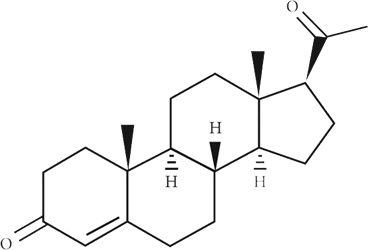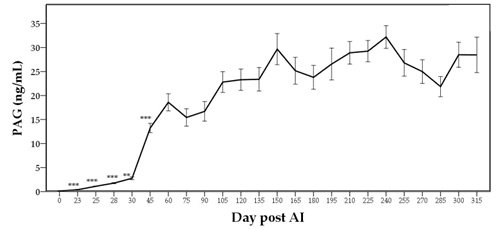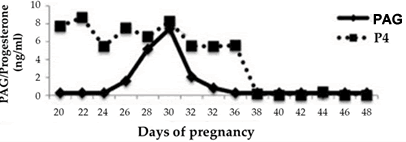Progesteron is the most well-known reproduction hormone presented in all mammals. It comes from the maternal corpus luteum. While PAG, the pregnancy associated glycoproteins are secreted by placenta and the embryo. These natural differences have decided the accuracy and applicability of utilizing these two as pregnancy markers in pregnancy diagnosis.

In another aspect, progesteron is a small molecule, the molar weight is 314.46 (right picture), while PAGs are a classes of glycoproteins, which include PAG-1, PAG-2, PAG-3, etc, in total more than 20 kinds of proteins.
Application of Progesterone in Bovine Reproduction
Progesterone (P4) from the corpus luteum is critical for the establishment and maintenance of pregnancy and plays a major role in regulating endometrial secretions essential for stimulating and mediating changes in conceptus growth and differentiation throughout early pregnancy in ruminants. Reduced P4 concentrations during growth of the ovulatory follicle are associated with lower fertility.
In cattle reproduction, the progesterone controlled internal drug releasing device (CIDR, a Zoetis product) is used for 7 days can shorten the time it takes for cows to come into heat after calving. The use of a CIDR can induce ovulation and initiate cycling earlier than may occur naturally, in cows that are at least 20 days post calving. By initiating estrus earlier, cows are more likely to conceive earlier in the breeding season. This initial estrus induced through the use of a CIDR is fertile and cows can be bred either by artificial insemination or through the use of natural service.
Application of PAG in pregnancy diagnosis and embryo loss prediction
The concentration of circulating pregnancy associated glycoproteins (PAGs) early in pregnancy may serve as markers to diagnose pregnancy or to predict late embryonic mortality or fetal mortality in cattle, which have been reported in many publications. There are also several commercial PAG based test kits for the pregnancy detection in bovine and other ruminants, including RIA-based , ELISA-based and lateral flow based kits, which were all proven to work properly.

The left diagram is from the research by Barbato et al (2017), from which we can see that PAG level rises from the beginning of pregnancy and continue to grow during the whole gestation and after delivery. This is also the reason why it can be used as a diagnostic marker for pregnancy.

In another research by Pohler, we can see that after embryo loss, both PAG and Progesterone levels decreased to close 0, while P4 drops slower than PAG with a gap of around 4 days, this indicated that PAG is more suitable for embryo loss monitoring.
References
- Wallace, R. M., Pohler, K. G., Smith, M. F., & Green, J. A. (2015). Placental PAGs: gene origins, expression patterns, and use as markers of pregnancy. Reproduction (Cambridge, England), 149(3), R115–R126. https://doi.org/10.1530/REP-14-0485
- Gorzecka, J., Codrea, M. C., Friggens, N. C., & Callesen, H. (2011). Progesterone profiles around the time of insemination do not show clear differences between of pregnant and not pregnant dairy cows. Animal reproduction science, 123(1-2), 14-22. https://doi.org/10.1016/j.anireprosci.2010.11.001
- Lonergan, P., Forde, N., & Spencer, T. (2016). Role of progesterone in embryo development in cattle. Reproduction, fertility, and development, 28(1-2), 66–74. https://doi.org/10.1071/RD15326
- Lonergan, P., & Sánchez, J. M. (2020). Symposium review: Progesterone effects on early embryo development in cattle. Journal of dairy science, 103(9), 8698–8707. https://doi.org/10.3168/jds.2020-18583
- Guide to Estrus Synchronization Products, MU Extension (missouri.edu), https://extension.missouri.edu/publications/g2022
- Pohler, K. G., Peres, R. F. G., Green, J. A., Graff, H., Martins, T., Vasconcelos, J. L. M., & Smith, M. F. (2016). Use of bovine pregnancy-associated glycoproteins to predict late embryonic mortality in postpartum Nelore beef cows. Theriogenology, 85(9), 1652–1659. https://doi.org/10.1016/j.theriogenology.2016.01.026
- Barbato, O., Menchetti, L., Brecchia, G., & Barile, V. L. (2022). Using Pregnancy-Associated Glycoproteins (PAGs) to Improve Reproductive Management: From Dairy Cows to Other Dairy Livestock. Animals : an open access journal from MDPI, 12(16), 2033. https://doi.org/10.3390/ani12162033